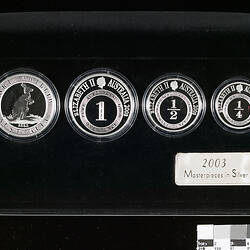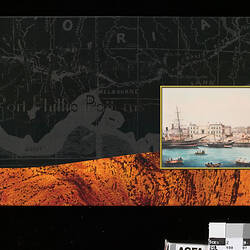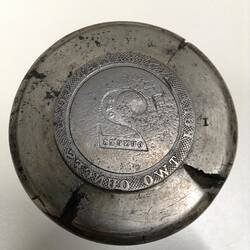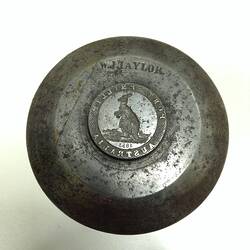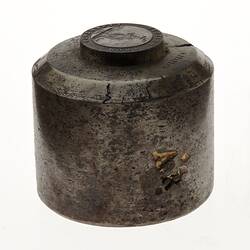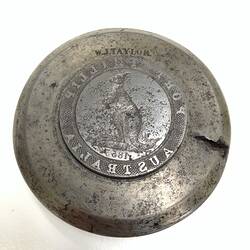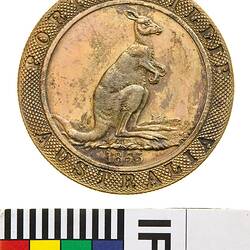Summary
Australia
Masterpieces in Silver, 2003
1853 Port Phillip Patterns (Kangaroo Office Patterns) - set of 4 silver coins, including re-creations of the obverse of the quarter ounce, half ounce and one ounce and two ounce tokens. The two ounce has the full Ian Rank-Broadley obverse portrait of Elizabeth II while the other weights have a small portrait and full scale reproduction of the reverses of the original pieces.
Royal Australian Mint, Canberra
Engraved by Vladimir Gottwald.
Physical Description
A black felt covered case coins in case containing four silver coins encased in hard plastic capsules and booklet (giving an out of date history of the Kangaroo Office) and the Certificate of Authenticity No. 06916. The coins are: Silver one dollar coin: Obverse: reproduction of quarter ounce Port Phillip Pattern coin; around ELIZABETH II, head of Elizabeth II, AUSTRALIA 2003". Reverse: reproduction of Port Phillip Pattern coin ( kangaroo); around , cross- hatching" ONE DOLLAR" cross-hatching. Silver two dollar coin: Obverse: reproduction of half ounce Port Phillip Pattern coin; around ELIZABETH II, head of Elizabeth II, AUSTRALIA 2003". Reverse: reproduction of Port Phillip Pattern coin ( kangaroo); around , cross- hatching" TWO DOLLARS" cross-hatching. Silver five dollar coin: Obverse: reproduction of one ounce Port Phillip Pattern coin; around ELIZABETH II, head of Elizabeth II, AUSTRALIA 2003". Reverse: reproduction of Port Phillip Pattern coin ( kangaroo); around , cross- hatching" FIVE DOLLARS" cross-hatching. Silver ten dollar coin: Obverse: head of Elizabeth II ; around ELIZABETH II, /AUSTRALIA 2003/ TEN DOLLARS". Reverse: reproduction of Port Phillip Pattern coin ( kangaroo)
Obverse Description
Four round silver coins in clear plastic rectangular case.
Reverse Description
Four round silver coins in clear plastic rectangular case.
Significance
2003 was the 150th anniversary of the production of the Port Phillip Patterns, also known as the Kangaroo Office patterns. Museum Victoria lent its dies for the Patterns to the Royal Australian Mint, for an exhibition entitled "The Enigma of the Port Phillip Patterns". The Senior Collection Manager requested that this 2003 set be donated to MV at the time the dies were returned. The new coins were produced from enlarged pictures of the patterns from the British Museum.The Royal Australian Mint website explains : "The Patterns were four 'tokens' made from gold, weighing respectively one quarter ounce, one half ounce, one ounce and two ounces. They were to resemble money as closely as legally possible, but would be valuable and could be traded for their gold content. When the concept was developed, the miners of the Victorian gold fields were not receiving the full value for their gold. An England based die-sinker, WJ Taylor, devised a scheme to be able to buy gold from the miners, then upgrade and produce gold tokens obtaining the full value of the precious metal, and making a profit for himself and his partners". John Sharples' article in the Gold and Civilization catalogue refers to Reginald Scaife as the originator of this scheme. The Melbourne Exhibition certificate awarded to Scaife in 1854 was on display in "Etched on Bark".
The Kangaroo Office venture was unprofitable , so the office was closed down. The press was sold to Thomas Stokes in 1857. According to the database " The production of the Patterns was seen as a further strengthening of Melbourne's claim to have a mint established in the city." This set is a product aimed at collectors, but its association with such an important part of Victoria's numismatic history is so strong that it should be acquired.
More Information
-
Collecting Areas
-
Acquisition Information
Donation from Royal Australian Mint, Canberra, 26 Mar 2004
-
Date Issued
2003 AD
-
Mint
Royal Australian Mint, Canberra, Denison Street, Deakin, Greater Canberra, Australian Capital Territory, Australia, 2003
-
Artist
-
Inscriptions
4 coins in case with box. Silver one dollar coin: Obverse: ELIZABETH II AUSTRALIA 2003 PURE AUSTRALIAN GOLD QUARTER OUNCE 1/4. Reverse: ONE DOLLAR PORT PHILLIP AUSTRALIA 1853 Silver two dollar coin: Obverse:ELIZABETH II AUSTRALIA 2003 PURE AUSTRALIAN GOLD HALF OUNCE 1/2. Reverse: TWO DOLLARS PORT PHILLIP AUSTRALIA 1853 Silver five dollar coin: Obverse: ELIZABETH II AUSTRALIA 2003 PURE AUSTRALIAN GOLD ONE OUNCE 1. Reverse: FIVE DOLLARS PORT PHILLIP AUSTRALIA 1853 Silver ten dollar coin: Obverse: ELIZABETH II AUSTRALIA 2003 TEN DOLLARS IRB. Reverse: PORT PHILLIP AUSTRALIA 1853
-
Series
-
Material
Silver
-
Axis
12
-
Classification
-
Category
-
Discipline
-
Type of item
-
Dimensions
110 mm (Length), 200 mm (Width), 28 mm (Depth)
Dimensions for closed black box.
-
Shape
Rectangle
-
Keywords


